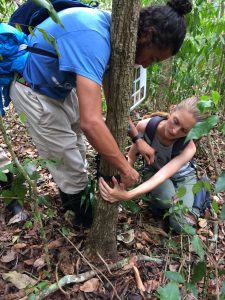DAY 11 – Today was a full day. I woke up when it was still dark outside, at 4:45 am. I rolled into my field clothes, the ever-stylish zip-off pants tucked into socks, and out onto the deck for bird-watching. We saw a couple of parrots, flying in a pair across the clearing, a Plumose Kite in a tree preening, and a Social Flycatcher on the research station railing. I want to see at least one Scarlet Macaw before we leave here.
After breakfast, Tian-Tian showed me a buzzing group of bees on the corner of the main research station building. They appeared to be stingless bees, in the tribe Meliponini. They might be Trigona fulviventris. I caught one, so if we have a chance I can look at it under a microscope. The bees were all bringing pollen, which you could see attached to their hind tibia, into their nest.

Our task for the day was to design an experiment, using camera traps to answer a question about the Chiquibul forest ecosystem. We chose to look at the presence of large cats and large cat prey in both on-path and off-path locations. We spent the whole day, from 9:45 am to 1:15 pm and again from 2:15 pm to 7:15 pm, hiking around and setting camera traps. As we were placing our last camera trap, the sun was setting so we hurried back, hiking the last 30 minutes in the dark. We will collect the camera traps and analyze the results on the last day here at Las Cuevas.

Some other highlights from today: eating a termite (it tasted like a root vegetable), seeing a Tommygoff when we were walking back to the station in the dark (the tommygoff is the most venomous snake in Belize), and taking a cold shower after soaking my shirt in sweat.
My tummy is full and my legs are tired, and I’m so ready to sleep.
